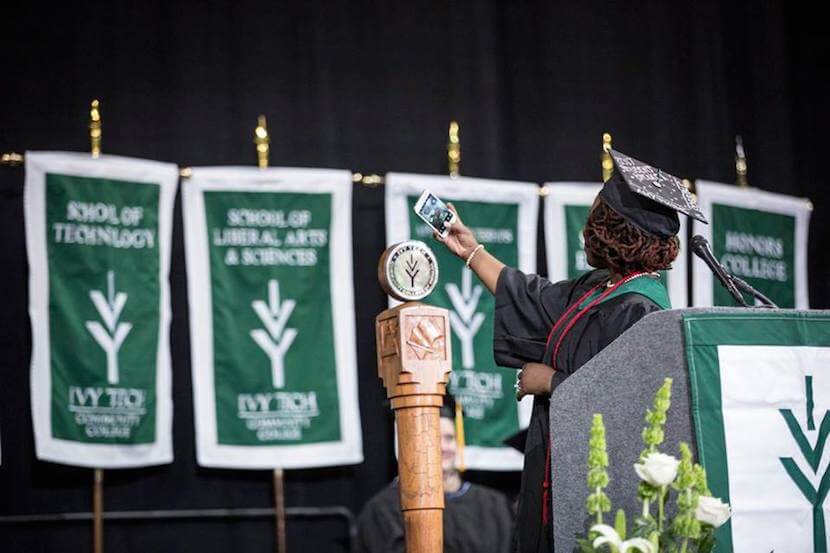Community Colleges have low graduation rates for a variety of reasons. Fewer than one out of five students at community colleges obtain their desired degree in three years or less, according to the Hechinger Report.
While the graduation rates are low, they don’t tell the whole story. Some leave to enter the workforce, some start families, some join the military, some transfer to four-year colleges, and others leave and come back later in life to complete their degree. In fact, one study found that more than 60 percent of students who transferred from two‐year colleges in the 2005 academic year ultimately obtained degrees at four‐year institutions.
Indiana has historically struggled with its graduation rates from the state’s two year colleges. In 2013, Indiana recorded an 8.8 percent graduation rate for students enrolled in community colleges. But things are beginning to look better. In 2016, Sue Ellspermann became president of Indiana’s largest community college system, Ivy Tech Community College. Ellspermann, who previously served as Lieutenant Governor under Vice President Mike Pence in Indiana, has helped lead an initiative that has increased the college’s graduation rates for students graduating within three years from 8.8 percent to 14 percent. This is a significant achievement, so TUN set out to find out the details of the initiative from Jeff Fanter, VP of Marketing and Communications at Ivy Tech.
How did Ivy Tech succeed in increasing graduation rates?
TUN was told that one of the most successful programs that has directly increased likelihood of graduation is the corequisite model. This model “has the student taking both the remedial course and the gateway course at the same time. So students are getting that refresher on certain skills just in time for them to utilize in the gateway course,” said Fanter. For underprepared students, the corequisite program can help them get past those entry-level courses and catapult them into work in their specific major.
Low unemployment rates in the state, financial stresses that make it difficult for students to attend classes full-time, low government funding, and full-time student’s desire to transfer are just some of the many outside factors that affect graduation rates.
Fanter explained that “low unemployment rates” play a factor into why Indiana has trouble keeping students enrolled at Ivy Tech.
“Students are able to find good-paying jobs prior to completion,” he said.
Indiana ranks near the bottom of the United States with only 33.2 percent of adults holding at least a two-year-degree. But the state ranks towards the top of the country with only 3.9 percent of the its citizens registered as unemployed. Working class citizens in Indiana don’t always feel the need to receive a college degree.
Part-time students often take classes around their work schedule. Putting work before college is practical and often a necessity, but it is detrimental to students’ chances of earning your degree.
“The key is encouraging part-time students to stay enrolled from term to term as continuous enrollment is key to completion,” said Fanter.
Mostly, students who attend Ivy Tech aren’t living in dorms and joining campus clubs. They are working long weeks to pay for their schooling and living expenses.
“These are students balancing work and life with school. So many are driven to be successful in all areas,” said Fanter.
Ivy Tech and community colleges all over the United States don’t receive as much state funding as their four-year counterparts. This makes it hard to hire enough staff to accommodate the 110,000 students throughout Indiana enrolled at Ivy Tech. The college has made it part of its goal to seek more student advisors.
Having a close ratio of advisors to students will “allow advisors to proactively reach more students and we know those interactions are important,” said Fanter.
Full-time students only make up one-third of the enrollment at Ivy Tech, and for some of those students their goal is to transfer. About 14 percent of students transfer from community colleges and, in six years or less, successfully earn their bachelor’s degree from a four-year college.
Since last year, the tone has changed at Ivy Tech.
“There is certainly more deliberate and proactive outreach taking place to currently enrolled students,” said Fanter.
Ivy Tech’s initiative to raise graduation rates does not stop here. The college has taken steps, but acknowledges there is more work to be done.



